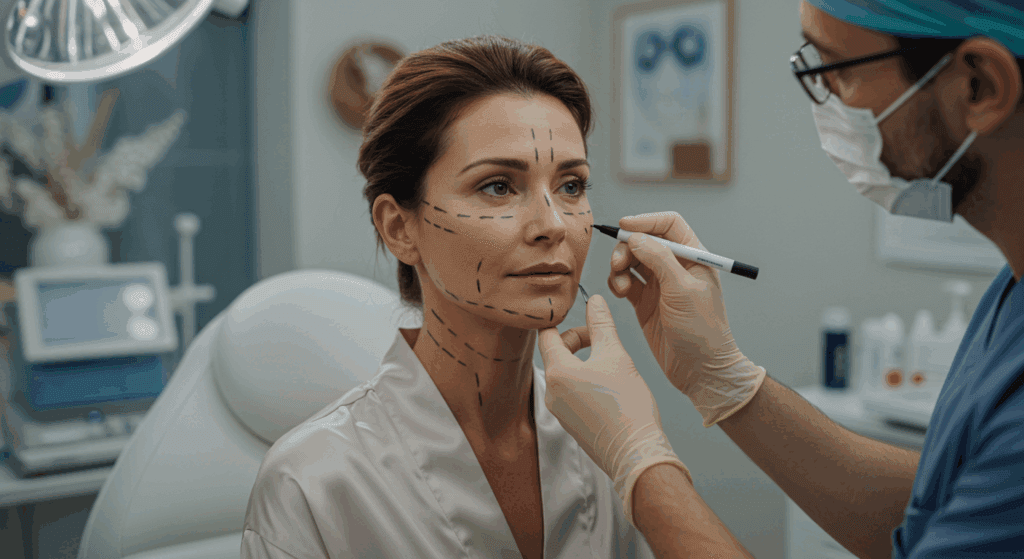Considering a facelift in Antalya? You’ve seen the stunning before-and-after photos and read the glowing testimonials. A masterful facelift is transformative, capable of erasing years to reveal a vibrant appearance that mirrors how you feel inside. It can restore the sharp jawline of your youth, lift sagging cheeks, and smooth the neck, leading to a profound boost in confidence that radiates through every aspect of your life. This is the promise of modern aesthetic surgery: not to create a different person, but to reintroduce you to the most refreshed and confident version of yourself.
But you are also rightly cautious. The world is full of cautionary tales and images of procedures gone wrong: the unnatural, “wind-swept” look, the loss of nuanced expression, or the tell-tale scars that betray the surgeon’s work. You want rejuvenation, not alteration. You want to look rested, not “done.”

What, then, is the secret that separates a subtle, brilliant result from a surgical failure? What is the defining factor that allows one person to look effortlessly youthful while another looks permanently surprised?
The answer lies far deeper than the skin. It’s found in a profound and unwavering respect for the intricate, multi-layered universe that makes up the human face. A modern, sophisticated facelift isn’t about pulling skin tight; it’s about meticulously understanding and restoring the face’s delicate, youthful architecture from its very foundations.
As a surgeon with over a decade dedicated exclusively to the complexities of facial aesthetics, I know that the most critical tool in the operating room isn’t the scalpel—it’s an exhaustive, three-dimensional knowledge of facial anatomy. This principle is the bedrock of my practice and is especially vital when you are considering a procedure in a world-class medical destination like Antalya, a city globally recognized for its exceptional standards of surgical care and patient experience.
My name is Dr. Berat Çiğdem. In this comprehensive guide, I will take you on a journey beneath the surface to demystify the complex anatomy of the face. My goal is to empower you with knowledge, to show you precisely why my team’s commitment to this science is your greatest asset in achieving the beautiful, safe, and authentically natural-looking results you deserve.

Table of Contents
Chapter 1: More Than Skin Deep – The Face’s Multi-Layered Structure
Many people still assume a facelift is a simple matter of trimming and tightening excess skin. This was the predominant approach decades ago, and it’s precisely why older techniques so often produced a flat, stretched, and two-dimensional appearance. To truly appreciate the elegance of a modern facelift, one must first understand that the face is not a simple canvas; it is a complex sculpture composed of several distinct layers, each playing a crucial role in the symphony of aging.
1. The Skin: The Expressive Surface
The skin is our most visible layer, but in the context of a facelift, it is the last piece of the puzzle to be addressed. In youth, our skin is rich in collagen and elastin, proteins that provide strength and resilience. As we age, and with cumulative sun exposure, these fibers break down. The skin thins, loses its snap, and develops fine lines and deep wrinkles. While a facelift redrapes the skin, its quality is not fundamentally changed by the procedure. This is why a lift is often paired with skin resurfacing treatments for a truly comprehensive result. The goal of the lift is to gently lay the skin over a newly restored foundation, without any tension at all.
2. Subcutaneous Fat: The Contours of Youth
Just beneath the skin lies a layer of soft, superficial fat. This isn’t just a uniform layer; it’s organized into distinct compartments that give the face its youthful, convex contours. Think of the full, high apples of the cheeks (the malar fat pad) or the soft fullness along the jawline. With age, two things happen to these fat compartments: they atrophy (shrink), and they descend due to gravity and the weakening of their supporting structures. The malar fat pad droops downwards and inwards, deepening the nasolabial fold (the smile line from nose to mouth) and creating a hollowed look under the eyes. This descent is a primary cause of jowling.
3. The SMAS (Superficial Musculoaponeurotic System): The Modern Facelift’s Key Player
This is the true game-changer in modern facial rejuvenation. The SMAS is not a muscle, but a strong, fibrous network that envelops your facial muscles, acting as an integrated scaffold. It connects the muscles to the overlying skin, meaning that when your muscles contract to form a smile, the SMAS transmits that movement to the skin. Crucially, as the SMAS weakens and sags with age, it doesn’t do so alone. It drags the overlying subcutaneous fat and skin down with it. This is the central mechanism behind the most prominent signs of facial aging. Therefore, an effective, long-lasting facelift must reposition this deeper layer. Simply pulling on the skin is like trying to make a bed by only pulling on the duvet; you must lift the mattress and sheets beneath it.
4. Retaining Ligaments: The Facial Anchors
Throughout the face, there are small but powerful fibrous bands called retaining ligaments. These ligaments act like rivets, anchoring the skin and SMAS to the deeper structures and underlying bone. In youth, they provide essential support. As we age, these ligaments stretch and weaken, allowing the facial tissues to droop more freely. A key part of an advanced facelift, such as the deep plane technique, involves the precise and strategic release of certain ligaments (like the zygomatic and masseteric ligaments). This release is what allows for a tension-free, dramatic, and natural repositioning of the facial tissues.
5. Deep Fat Compartments: The Foundational Volume
Beneath the SMAS lie even deeper pockets of fat. These compartments are stationary and do not descend in the same way as the subcutaneous fat. However, they are prone to significant atrophy, or volume loss, over time. This deflation contributes to a hollowed, gaunt, or tired appearance, particularly in the mid-cheek and temple area. Understanding this deep volume loss is critical, as lifting alone cannot fix it. This is where the artistry of fat grafting comes in, restoring this foundational volume to recreate a truly youthful facial shape.
6. Periosteum and Bone: The Craniofacial Scaffold
The bone is the foundational framework of our entire facial structure. While a facelift does not alter the bone, a surgeon’s understanding of its topography is essential. Over many decades, even our bones subtly resorb and change shape, particularly around the eye sockets and jawline, contributing to the overall aging process. A surgeon uses the bone’s prominences as landmarks for navigating the soft tissues safely and for anchoring their repairs.

Chapter 2: The SMAS and Deep Plane Facelift: Antalya’s Gold Standard
Now that we understand the layers, we can appreciate why the evolution of facelift techniques has moved progressively deeper. When you hear surgeons discussing advanced facelifts, they are almost always talking about how they manage the SMAS layer. At my clinic in Antalya, we moved beyond the limitations of outdated “skin-only” lifts long ago. By focusing our efforts on the structural SMAS layer, we achieve a lift that is not only more significant but also fundamentally more natural and durable.
Contrasting the Techniques
- Skin-Only Lift (Obsolete): This historical technique involved making an incision, pulling the skin tight, trimming the excess, and suturing it closed. The result was often a tight, stretched, and unnatural look because it ignored the underlying descent of the fat and SMAS. The tension placed on the skin closure also led to widened, visible scars and a very short-lived result, as skin would inevitably stretch back out.
- SMAS Plication/Imbrication: This was a major advancement. In this technique, the surgeon lifts the skin to expose the SMAS. The SMAS is then lifted and tightened—either by folding it onto itself (plication) or by trimming a section and suturing the edges together (imbrication)—and secured in a more youthful position. This is a very effective and safe technique for many patients, offering good results in the lower face and jowls.
- Deep Plane Facelift: This is currently the gold standard for comprehensive and seamless facial rejuvenation. Having trained with global pioneers in multi-layer facelifts, I can attest to its superior, integrated results. In a deep plane facelift, the surgeon does not separate the skin from the SMAS. Instead, after making the initial incision, the dissection goes underneath the SMAS layer. By releasing key retaining ligaments, we are able to lift the SMAS, muscle, and overlying fat and skin together as a single, composite unit.
Why Does the Deep Plane Technique Matter For You?
- A Truly Natural, “Un-Pulled” Look: Because we are lifting the face’s deeper structural tissues as a single unit, the skin is carried along passively. It can be re-draped gently over the new, youthful contours without any tension whatsoever. This is the absolute key to avoiding an “operated-on” appearance and ensuring scars heal as fine, imperceptible lines.
- Powerful Mid-Face Rejuvenation: By releasing the zygomatic ligaments over the cheekbone, the deep plane technique allows for a powerful vertical lift of the malar fat pad. This restores the high, full cheek contour of youth and softens the tear trough and nasolabial fold in a way that other techniques cannot match.
- Longer-Lasting Results: The SMAS is a strong, durable layer. A repair that relies on repositioning this deep structure will hold its shape for many more years—often a decade or more—than a skin-only or even a standard SMAS lift.
- Harmonious Jawline and Neck Rejuvenation: The SMAS in the face is directly connected to the platysma muscle in the neck. By mobilizing the SMAS, we create a powerful and seamless rejuvenation of the entire lower face and neck, eliminating the “turkey neck” and restoring a crisp, well-defined cervicomental angle (the angle beneath the chin).
This focus on advanced, anatomically precise techniques is the cornerstone of my surgical philosophy. It is how my team and I deliver the sophisticated, lasting results that our international patients from the UK, Europe, and beyond expect when choosing a facelift in Antalya.
Chapter 3: Navigating the Facial Landscape: The Primacy of Patient Safety
Deep anatomical knowledge is not just about creating beauty—it is fundamentally and non-negotiably about patient safety. The face is a delicate, three-dimensional landscape, crisscrossed with vital nerves and blood vessels that must be meticulously identified, respected, and preserved.
The Facial Nerve: A Surgeon’s Ultimate Responsibility
The single most critical structure to protect during any facelift procedure is the facial nerve (the seventh cranial nerve). This nerve emerges from the skull just behind the ear and then branches out like a tree across the face, controlling every muscle of facial expression—your ability to smile, to frown, to raise your eyebrows, to pucker your lips, to blink. An injury to any of its branches can be devastating and, in some cases, permanent.
As a member of ISAPS (International Society of Aesthetic Plastic Surgery), I am bound by the highest global standards of patient safety. My entire surgical technique is built on one non-negotiable principle: identify and protect the facial nerve at all costs. This is not a passive hope; it is an active, multi-faceted strategy:
- Mastery of Anatomical Landmarks: The facial nerve and its branches follow a predictable path. An expert surgeon has a precise mental map of these pathways and the anatomical landmarks that signal their location, even when a patient’s individual anatomy varies slightly.
- Operating in the Correct Surgical Plane: This is a crucial advantage of the deep plane technique. The dissection is carried out in a specific anatomical layer that lies naturally beneath the facial nerve. This creates an inherent layer of safety, as the nerve remains protected in the overlying composite flap.
- Meticulous Dissection Technique: There is no substitute for careful, precise surgical skill performed under direct vision, often with the aid of loupe magnification and fiberoptic lighting. It means knowing what tissue to cut, what to spread, and when to proceed with the utmost caution.
When you choose a surgeon for your facelift, you are placing your face and your identity in their hands. You must be absolutely confident that they possess the deep anatomical expertise to navigate this delicate territory flawlessly.
Chapter 4: The Art of Incisions – Hiding the Evidence of Surgery
Even the most beautiful facial rejuvenation can be marred by poorly placed or poorly healed incisions. A significant part of the surgical craft is planning and executing incisions so that, once healed, they are virtually undetectable to the casual observer. The goal is for you to be able to wear your hair up or cut it short with complete confidence.
Incision planning is tailored to each patient’s anatomy, hairline, and specific goals. A typical facelift incision begins within the hairline of the temple, extends downwards following the natural curve just in front of the ear (or hiding just inside the ear canal’s opening, known as a pre-tragal or retro-tragal incision), curves around the earlobe, and then extends back into the hairline behind the ear.
The skill lies in:
- Preserving the Hairline: Incisions are planned to avoid shifting the sideburn or raising the hairline, which are tell-tale signs of a poorly planned lift.
- Respecting Anatomical Subunits: The incision line is camouflaged within the natural creases and transitions of the face, such as the border between the cheek and the ear.
- Tension-Free Closure: As discussed, because a deep plane lift places all the tension on the deep SMAS layer, the skin can be closed with absolutely zero tension. This is the single most important factor in achieving a hairline-fine scar. Skin closed under tension will always heal with a wider, more visible scar.
Chapter 5: Restoring Volume – The Three-Dimensional Approach with Fat Grafting
Aging is not just about sagging; it’s equally about volume loss. A face that has been lifted but not re-volumized can look tight and hollow, which is not a youthful look. To create a truly authentic and vibrant result, we must address the third dimension: volume.
This is achieved through a procedure called autologous fat grafting (or lipo-filling).
- Harvesting: A small amount of fat is gently harvested from another area of the body, such as the abdomen or thighs, using a specialized liposuction technique.
- Processing: This fat is then carefully processed—purified and concentrated—to isolate the healthy, viable fat cells and stem cells.
- Injection: Using fine cannulas, the purified fat is then artistically injected in tiny droplets into the areas of the face that have lost volume. Common areas include the temples, the tear troughs under the eyes, the cheeks, and the nasolabial folds.
Fat grafting does more than just fill space. The stem cells within the transferred fat also have a regenerative effect on the overlying skin, improving its texture, thickness, and glow over time. The combination of lifting the sagging structures and refilling the deflated compartments is what restores the soft, convex, and heart-shaped contours of the youthful face.

Conclusion: Your Blueprint for a Natural and Lasting Result
Choosing to have a facelift is a significant decision. The success of your journey hinges on a single, crucial element: the anatomical expertise of your chosen surgeon. A modern facelift is a procedure of immense sophistication, one that demands a deep understanding of the face’s intricate, multi-layered structure.
It is about repositioning the foundational SMAS layer to create a natural, tension-free lift. It is about navigating the delicate landscape of nerves and blood vessels with unwavering precision to ensure your safety. It is about restoring lost volume to recreate youthful contours and artfully concealing incisions to leave no trace.
This intricate knowledge isn’t learned overnight. It is the culmination of years of dedicated, specialized training—from my medical degree at the prestigious Gülhane Military Medical Academy to my specialist education at Gaziantep University and continuous international training at world-renowned institutions like Harvard Medical School. It is this depth of experience that ensures both the beauty and the safety of your result.
If you are considering a facelift in Antalya, I invite you to prioritize this anatomical approach. Ask your surgeon to explain the layers of the face. Discuss their technique for addressing the SMAS. Inquire about their strategies for nerve protection. Your face is your identity. Entrust it to a surgeon whose philosophy is built on the bedrock of anatomical science, surgical precision, and artistic vision.
Frequently Asked Questions (FAQ)
Q1: What is the main difference between a modern facelift and the older techniques I’m worried about?
The primary difference lies in what is being lifted. Older, traditional facelifts often just pulled the skin tight. This ignored the deeper, underlying structures that were the true cause of sagging, resulting in a temporary, two-dimensional, and often “wind-swept” look. A modern facelift, such as the SMAS or Deep Plane technique, addresses the deeper foundational layer of the face—the Superficial Musculoaponeurotic System (SMAS). By lifting this structural layer, the overlying skin can be redraped naturally and without tension, which is the secret to a sophisticated and long-lasting result.
Q2: You talk a lot about the “SMAS.” Why is it so important?
The SMAS is a strong, fibrous network that envelops your facial muscles and acts as a supportive scaffold for your facial fat and skin. As we age, this is the layer that truly weakens and descends, bringing everything with it and causing jowls and deep facial folds. A truly effective facelift must correct this foundational sagging. Ignoring the SMAS and only tightening the skin is like trying to fix a sagging tent by pulling on the fabric instead of tightening the ropes and poles. Repositioning the SMAS provides a more powerful lift and a result that lasts for many more years.
Q3: Is a Deep Plane Facelift better? What makes it a “gold standard”?
The Deep Plane Facelift is considered a gold standard because it offers the most comprehensive and harmonious rejuvenation. In this advanced technique, we lift the SMAS, muscle, fat, and skin together as a single, composite unit. This is possible by releasing key retaining ligaments that tether these tissues down. This method provides three key advantages:
- Superior, Natural Results: It creates a powerful, tension-free lift that beautifully restores the youthful contours of the cheeks and mid-face.
- Enhanced Longevity: The repair is done on the deep, strong structural tissues for a result that endures.
- Inherent Safety: The surgical dissection occurs in a plane that is naturally beneath the critical facial nerves, providing an extra layer of protection for them.
Q4: How do you ensure my results will look natural and not obviously “done”?
Achieving a natural result is the core principle of my entire surgical philosophy, and it’s based on three pillars:
- Tension-Free Skin Closure: By doing all the lifting work on the deep SMAS layer, the skin is simply redraped gently over the new contours. There is no tension on the incision lines, which is the number one reason for a “pulled” look and poor scarring.
- Three-Dimensional Restoration: Aging isn’t just sagging; it’s also volume loss. I almost always combine a facelift with fat grafting to restore youthful volume to areas like the cheeks and temples. This avoids a hollow or gaunt look and restores the soft, convex shape of a young face.
- Artistic Incision Placement: Scars are meticulously hidden within the natural creases in and around the ear and within the hairline, making them virtually imperceptible once healed.
Q5: I’m concerned about safety, especially damage to facial nerves. How do you prevent this?
Patient safety is my absolute, non-negotiable priority. Protecting the facial nerve, which controls all your expressions, is a surgeon’s ultimate responsibility. My strategy is built on an exhaustive knowledge of facial anatomy. I know precisely where the nerve branches are located and how to avoid them. The Deep Plane technique provides an extra margin of safety because the entire surgery is performed in a layer underneath the facial nerve. This, combined with meticulous, careful dissection under magnification, ensures that the vital structures of your face are protected at all times.
Q6: Will I have visible scars after my facelift?
The goal of a modern facelift is for you to be able to wear your hair up or short with complete confidence. Scars are inevitable with any surgery, but they should not be obvious. I achieve this by:
- Camouflaging Incisions: Placing them in natural anatomical transitions, like the crease where the ear meets the cheek and within the hairline.
- Ensuring Tension-Free Closure: This is the most critical factor. Because the lift is supported by the deep SMAS layer, the skin edges come together without any tension, allowing them to heal as fine, pale lines rather than wide, noticeable scars.

